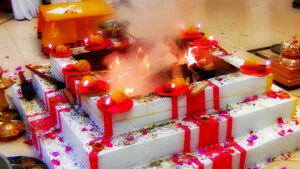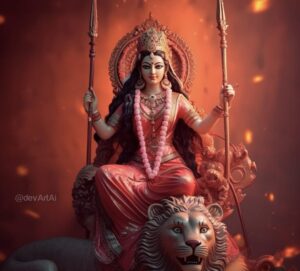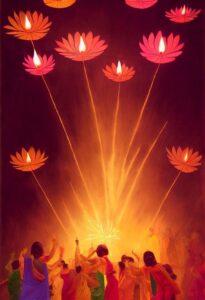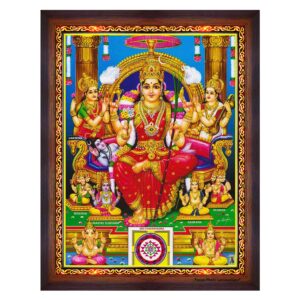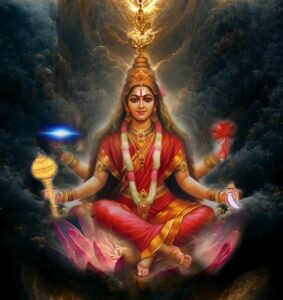“Amidst the vibrant celebrations of Navaratri, where goddesses dawn their most benevolent forms, there exists a night of profound transformation and awe-inspiring divinity. As the seventh day of this grand festival unfolds, the fierce and awe-striking form of Goddess Durga makes her majestic appearance – she is Kalaratri, the Dark Goddess. The name “Kalaratri” can be broken down into “Kala,” which means time or darkness, and “Ratri,” which means night. Thus, Kalaratri is often referred to as the “Dark Night” or “Goddess of the Night.”With a complexion as dark as the darkest night, Kalaratri is a symbol of raw power, relentless courage and the unwavering fight against darkness and evil. Join me on a journey to explore the enigmatic and fierce avatar of Kalaratri, as we delve into her captivating legend and spiritual significance.”

Story of Kalaratri:
The emergence of Goddess Kalaratri is deeply intertwined with the cosmic narrative of the Hindu pantheon. Here is the story of how Kalaratri, the dark and fierce form of the Divine Mother, came into existence:
In the age-old saga of creation, preservation, and destruction, the cosmos experienced cycles of existence. During one such cycle, a formidable demon named Raktabeej emerged. Raktabeej had a unique and menacing power; every drop of his blood that fell on the ground would spawn a clone of him. This extraordinary ability made him virtually invincible and posed a significant threat to the balance of the universe.
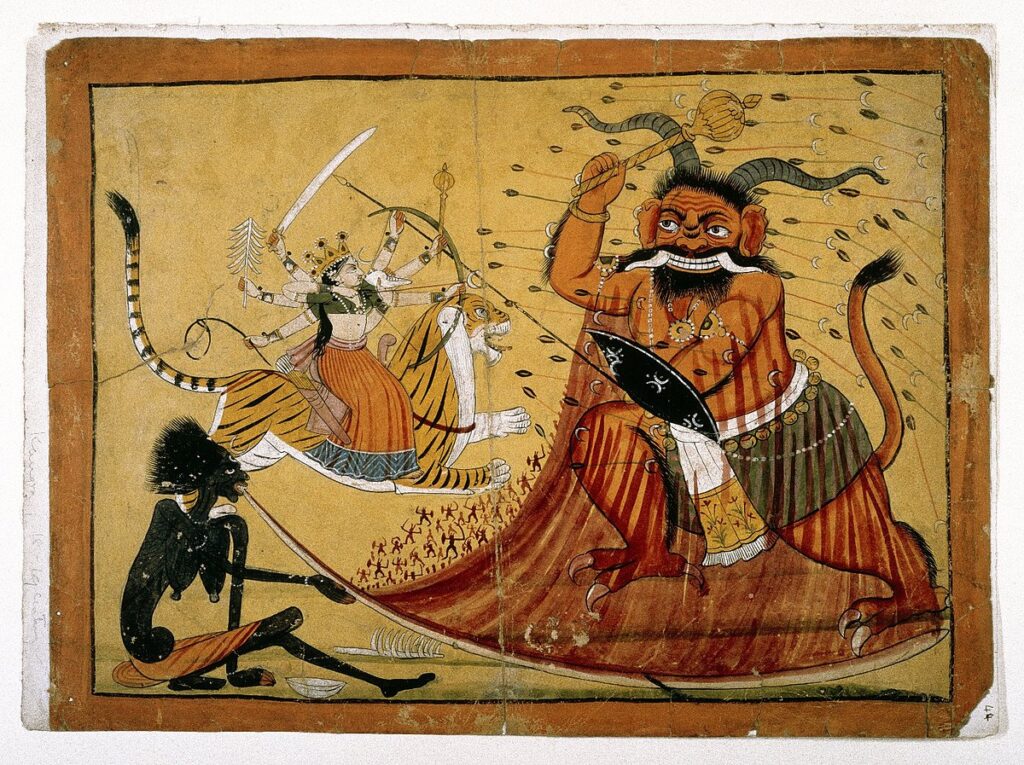
As Raktabeej wreaked havoc across the realms, the gods realized that traditional divine intervention wouldn’t be enough to subdue him. Their only hope lay in invoking a force that could match his destructive powers with equal ferocity.
In response to their plea, a divine energy began to manifest itself. It was a pitch-black, fierce and awe-inspiring form, radiating an aura of raw power. This embodiment of cosmic energy and primordial darkness became known as Kalaratri, which translates to “the One who is the Night of Time.”
Kalaratri, with her relentless resolve and untamed strength, mounted an aggressive assault on the formidable demon. She fought fearlessly, her eyes blazing with the determination to quell the dark menace that threatened the universe. In the epic battle that ensued, Kalaratri’s sword clashed with Raktabeej’s weapons, her laughter echoing through the cosmic expanse.
With her divine prowess, Kalaratri managed to overcome the seemingly invincible demon. She pierced his body and made sure not a single drop of his blood could reach the ground. The annihilation of Raktabeej marked a momentous victory in the cosmic struggle between good and evil.
- Fierce Appearance: Kalaratri is depicted as having a fierce appearance. She is often described as having a dark complexion and disheveled hair. She is adorned with a garland of skulls and is sometimes shown with a sword in one hand and a fiery torch in the other.
- Destroyer of Demons: Kalaratri is believed to be the destroyer of demons and evil forces. Her fierce form is associated with the eradication of negativity and the protection of her devotees.
- Symbol of Time: As her name suggests, Kalaratri is closely associated with time and the night. She is the embodiment of the relentless march of time and the inevitable cycle of life, death and rebirth.
- Blessings of Courage: Worshiping Kalaratri is said to bestow courage and strength upon her devotees. She helps them overcome fear and face challenges with determination.
- Chandrahasa: Kalaratri is often depicted with a crescent moon-shaped ornament on her forehead. This symbolizes the waxing and waning phases of the moon and the passage of time, emphasizing her connection to the concept of time.
- Protector of the Universe: Kalaratri is believed to be the ultimate protector of the universe. Her fierce and determined form signifies her role in safeguarding the cosmic order and ensuring the balance of life and death.
- Destruction of Ignorance: Her fiery nature and weaponry are seen as tools to destroy ignorance and illusions. Devotees seek her blessings to overcome ignorance and attain spiritual enlightenment.
- Courage in Adversity: Worshiping Kalaratri is associated with gaining the strength to face adversity and challenges in life with unwavering determination. She instills the courage to confront obstacles and emerge victorious.
- Removal of Malefic Influences: It is believed that by worshiping Kalaratri, devotees can get rid of malefic influences, black magic and negative energies. She is invoked for protection against external and internal threats.
- Color of Power: The royal blue color associated with Kalaratri represents power, strength and the ability to overcome darkness. Devotees often wear blue attire during her worship.
- Night’s Blessings: The dark night, symbolized by Kalaratri, is seen as a source of blessings and solace. While she embodies the darkness, she also provides comfort and protection during the night.
- Method of Worship: in the worship of Maa Kalratri, devotees should present flowers, fresh medicinal herbs, fragrant incense, and radiant oil lamps to the goddess. It is considered highly auspicious to offer halwa and kheer to Maa Kalratri. During the worship, reciting ‘Goddess Sukta’ and ‘Ratri Sukta’ adds to the sacredness of the occasion.
- Cosmic Dance of Time: Kalaratri’s form is a reminder of the eternal cosmic dance of time, where everything undergoes transformation. She teaches us that change is an inherent part of existence.
- Astrological Connection: Goddess Kalaratri governs planet Shani.
- The dark energy that envelops the entire universe, providing solace and comfort to all beings, is aptly named ‘Ratri.’ It’s during the tranquil hours of the night, in the embrace of Ratri, that we discover profound comfort. Finding solace in the nighttime is truly a blessing bestowed by Ratri.
